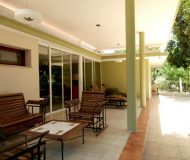Dining in Cuba
Cuban food is a unique mix of Spanish, French, African and Caribbean cuisines, and full of intense, rich flavours. During colonial times, Spanish and French traders who settled on Cuba and neighbouring islands such as Haiti brought with them European culinary traditions, while African slaves brought in to work on the sugar plantations added some of their own culture to the mix. Around Havana, a small Chinese minority also offers some Cantonese and Hakka food options.
Tropical Delights
A major factor in Cuban cuisine is the island’s tropical climate, which supports an abundance of plant life meaning that Cuban dishes are rich in tropical fruit and vegetables. Surrounded by water, there are also significant amounts of seafood on Cuban menus, including various fish and shell fish options. The main staples are rice and root vegetables such as yuca (or cassava), malanga, and boniato, which are boiled, fried or used in stews.
The main protein in Cuban cuisine comes from plenty of beans, chicken, pork and beef and, of course, seafood. Meat is often used in stews to make as much out of it as possible, served with rice or kidney beans.
One of the most common flavour enhancers in the Cuban kitchen is sofrito, a type of sauce or marinate of Spanish origin used as a base for vegetables and meat dishes alike. Variations exist but Cuban sofrito will typically include Spanish onions, garlic, and green bell peppers plus additional flavourings such as tomato sauce, white wine, cumin, bay leaf and cilantro are also common.
Go Local
Some visitors may find the food in Cuba rather simple and due to various trade restrictions and a general lack of resources, some government owned restaurants sometimes run short of supplies. However, privately owned restaurants are becoming increasingly popular, and some of them serve up delicious, authentic local food. Another good option are paladars, which offer private home cooking. These unique eateries were introduced legally in the 1990s in order to allow Cubans to earn money through private enterprise. As more economic reforms have materialised, so too have these paladars increased in terms of numbers and quality. Today you will find a great selection of not only Cuban, but also international food on offer to guests from private homes.
One of the must-try dishes when you’re in Cuba is the ropa vieja, which is a stew made of shredded beef, green peppers, tomatoes onion and garlic. Lechón, or suckling pig, is another proud local dish, marinated in garlic, onions and herbs and slow roasted on a spit.
Sweet Life
For those with a sweet tooth, Cuba is the right place. Due to the island’s many plantations, sugar is one of the staples that Cuba never runs out of, which is definitely reflected in the nation’s desserts and snacks. Stock up on torticas, sweet shortcake biscuits, for those long bus rides, or get high on sugar with the overly sweet cocos or coquitos, confections made of coconut and brown sugar.
All that sugar is also used in the production of Cuba’s world famous rum and the popular drinks that use it as an essential ingredient. Havana Club is the most widely available brand on the island, but other smaller brands such as Santiago de Cuba, named after the second largest city, Caribbean Club and Siboney are also worth a taste.
Where to Dine
The number of paladars in Cuba has been increasing at astonishing speed in recent years, but for some tried and tested food head to San Cristóbal in central Havana. Traditional fare such as rice and beans, malanga and roast pork dominate the menu, which also has a large dessert section offering including flan, fruit tart and pudding.
Another great local paladar in Havana is the one owned by Doña Eutemia, who has based the menu around her mother’s recipes. The ropa vieja is as traditional as it gets here, and the fact that the restaurant remains cosy and charming adds to the pleasure of the meal.






